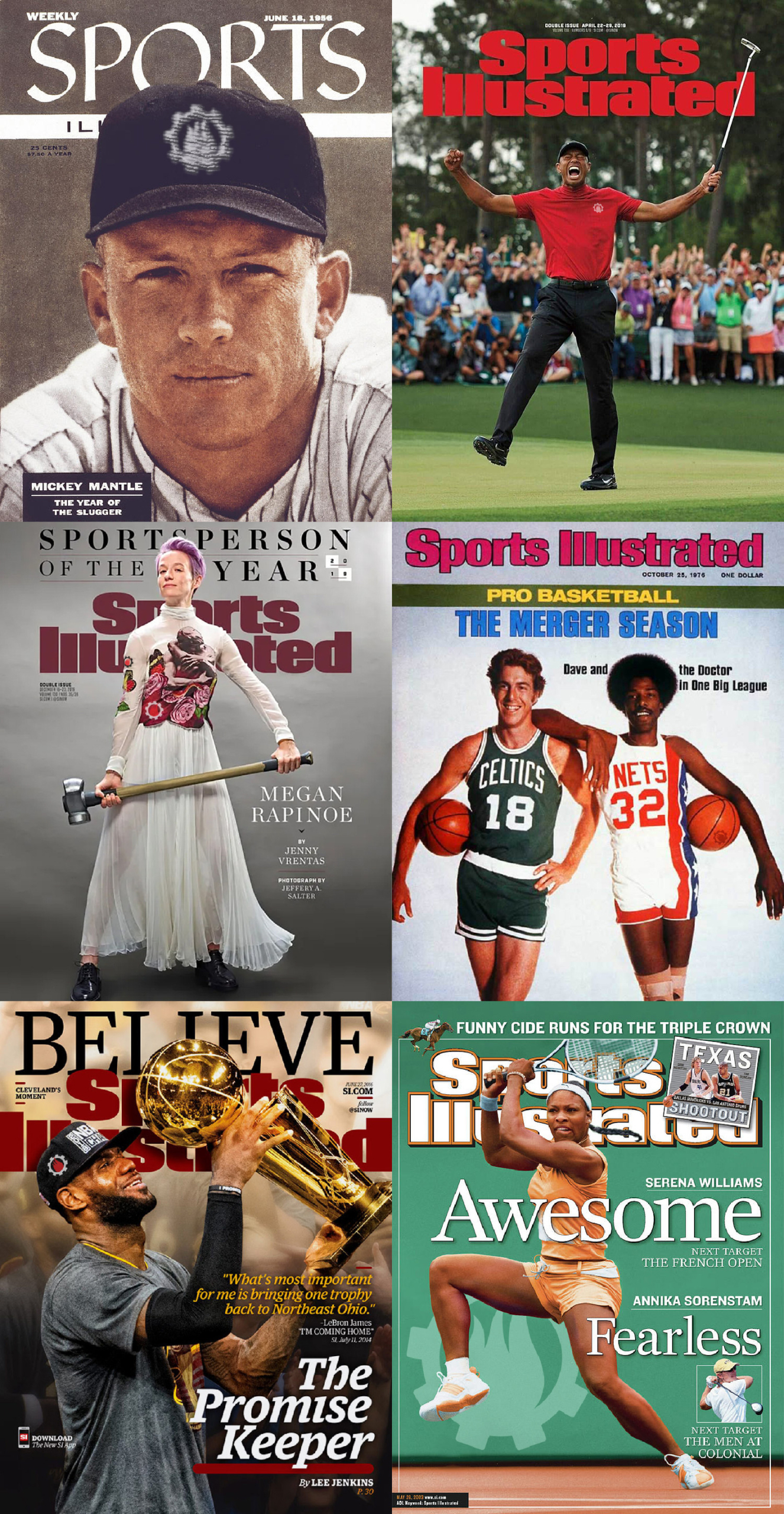Happy Birthday Sports Illustrated
Growing up during the 70s and 80s, it’s difficult for me to think of a magazine that was more influential to my “sports” youth than Sports Illustrated. We were lucky enough to get the magazine (for you youngin’s, that’s colored paper with photos and words, folded and stapled in a booklet filled with stories and advertisements) delivered directly to our house. My brothers (and sisters) would read all about the upcoming stars, the different sports throughout the world, and of course our favorite football, baseball and basketball players. The stories were magical, filling in things we would never know about athletes – their history, upbringing, and developed desire to be the best at what they do. Throughout the magazine, I got to see amazing photographs of bodies hurtling through the air, pounding one another, and racing for glory. One of my favorite sections was about various high school standout athletes across the country, these boys and girls accomplished some amazing things! I did some searching to find some trivia we can all enjoy (except the cover curse and my Brownies – ugh). Thanks to Google and Wikipedia for the info.

- Sports Illustrated (SI) is an American sports magazine that became one of the most influential sports publications in the world was first published on August 16, 1954, celebrating its 70th birthday today. SI was created by Henry Luce, the founder of Time magazine, who saw a need for a magazine that would cater to sports enthusiasts.
- The inaugural issue of Sports Illustrated featured Milwaukee Braves star Eddie Mathews at bat on the cover. The first issue was notable for its fold-out section featuring the detailed plans for Milwaukee County Stadium, a cutting-edge venue at the time. (10 trivia things to know about the first edition)
- Initially, the magazine aimed to reach the upscale, well-educated, and affluent audience. It featured a mix of major sports coverage, as well as articles on upscale hobbies such as yachting, polo, and safari hunting… (now that’s a popular sport??)
- Sidney L. James was the first managing editor of Sports Illustrated. He played a significant role in shaping the magazine’s early editorial direction.
- Sports Illustrated was one of the first magazines to heavily incorporate color photography, making it visually appealing and setting a new standard for sports publications. From the start, it played a pivotal role in legitimizing sports journalism, with in-depth articles, high-quality photography, and professional reporting.
- The famous Sports Illustrated Swimsuit Issue debuted in January 1964, with Babette March on the cover. This special edition became an annual tradition and one of the best-selling issues each year. Years later, non-models made the cover, including 81 year old Martha Stewart.
- In 1954, the magazine began the tradition of selecting a “Sportsman of the Year,” an honor given to the athlete or team that represented the spirit of sportsmanship and excellence. The first recipient was Roger Bannister, who had broken the four-minute mile earlier that year.
- As the magazine introduced various innovations in sports journalism, including detailed statistics, extensive player profiles, and behind-the-scenes coverage, which have now become standard in sports reporting.
- The “Sports Illustrated Cover Curse” is a popular sports superstition that suggests individuals or teams featured on the cover of the magazine are likely to experience bad luck, poor performance, or injuries shortly after their appearance. Here are some notable instances often cited as evidence of the curse:
- Eddie Mathews (1954): The very first issue of Sports Illustrated featured Eddie Mathews of the Milwaukee Braves on the cover. Shortly after, Mathews injured his hand, missing seven games in the 1954 season.
- Ken Norton (1977): Ken Norton was featured on the cover in March 1977, just before his title fight against Muhammad Ali. Norton lost the fight in a controversial decision, leading many to believe in the curse.
- Pittsburgh Steelers (1979): After winning Super Bowl XIII, the Steelers were featured on the cover. The following season, they failed to make the playoffs, which was considered a disappointment given their previous success.
- Mark Fidrych (1977): The charismatic Detroit Tigers pitcher appeared on the cover in 1977. Shortly after, he suffered a knee injury, and his career quickly declined due to various physical problems.
- Jon Peters (1989): High school pitcher Jon Peters, who set a national record with 51 consecutive wins, was featured on the cover in 1989. Following his appearance, he lost his next game, ending his winning streak.
- Nomar Garciaparra (2001): The Boston Red Sox shortstop appeared on the cover in April 2001, just before suffering a wrist injury that required surgery and sidelined him for most of the season.
- Michael Spinks (1986): Boxer Michael Spinks was featured on the cover just before his fight with Mike Tyson in 1988. Spinks was knocked out in 91 seconds, a shocking and decisive defeat.
- Brett Favre (1995): Brett Favre appeared on the cover during the 1995 season, and shortly after, the Packers lost in the NFC Championship Game.
- Kerry Wood (1998): The Chicago Cubs pitcher, after striking out 20 batters in a game, was featured on the cover. He then experienced injuries that affected his career.
- Serena Williams (2003): After winning four consecutive Grand Slam titles, Serena Williams was featured on the cover. She then suffered a knee injury that required surgery, affecting her performance.
- And then there are our “Browns” – with several instances where the “Sports Illustrated Cover Curse” seemed to affect them. Here are a few notable examples:
- Bernie Kosar (1989): Bernie Kosar, the Browns’ quarterback, appeared on the cover in September 1989. Shortly after, the team suffered a series of losses, and Kosar dealt with injuries, impacting his performance and the team’s success that season.
- Tim Couch (1999): Tim Couch was featured on the cover in 1999 after being selected as the first overall pick in the NFL Draft by the Browns. His career was plagued by injuries and inconsistent performance, and he never lived up to the expectations set for a top draft pick.
- Brady Quinn (2007): Brady Quinn appeared on the cover in 2007, shortly after being drafted by the Browns. Quinn struggled to find success in the NFL, facing injuries and eventually losing his starting position.
- Peyton Hillis (2011): Peyton Hillis, a relatively unknown running back, had a breakout season in 2010, rushing for over 1,000 yards and scoring 13 total touchdowns. Due to his standout performance, Hillis was voted by fans to appear on the cover of the “Madden NFL 12” video game, which coincided with a Sports Illustrated cover story. After the cover appearance, Hillis’ career took a downturn as he suffered multiple injuries, including a hamstring injury that sidelined him for several games. Hillis’ performance significantly declined, and he failed to replicate his 2010 success, finishing the 2011 season with only 587 rushing yards and 3 touchdowns. After the 2011 season, Hillis bounced around several teams but never regained his previous form and retired from the NFL in 2015.
- Johnny Manziel (2014): Johnny Manziel, also known as “Johnny Football,” was featured on the cover in 2014 after being drafted by the Browns. His career with the team was marked by off-field controversies, inconsistent play, and eventual release from the team.
The “curse” remains a topic of debate, as many athletes have appeared on the cover without experiencing any negative effects often seen as a coincidence or a fun superstition rather than a genuine phenomenon.
In 1990 Sports Illustrated became part of Time Warner, which was formed by the merger of Warner Communications and Time Inc. When the latter was spun off in 2014, it retained Sports Illustrated.
In 2018 Meredith Corporation gained control of the magazine through its acquisition of Time Inc., and that year Sports Illustrated, which faced declining subscriptions, began publishing its regular weekly edition once every two weeks. In 2019 the magazine’s intellectual property was sold to Authentic Brands Group for $110 million. As part of the deal, Meredith would continue to publish Sports Illustrated through a licensing agreement.
Later in 2019, the digital media company TheMaven, Inc. acquired the magazine’s publishing rights for at least 10 years as Sports Illustrated became a monthly publication in 2020, though it continued to release special issues.
In January 2024 TheMaven, now renamed The Arena Group, had its licensing agreement terminated after it failed to make a payment; it also laid off most of the magazine’s staff. Two months later, Authentic Brands Group said it had reached an agreement for the publisher Minute Media to take over publishing rights to Sports Illustrated. Hopefully, SI can continue to publish into the future.
DO YOU LIKE CONTESTS?
Me, too.
As you may know, the Kowalski Heat Treating logo finds its way into the visuals of my Friday posts.
I. Love. My. Logo.
One week there could be three logos.
The next week there could be 15 logos.
And sometimes the logo is very small or just a partial logo showing.
But there are always logos in some of the pictures.
So, I challenge you, my beloved readers, to count them and send me a quick email with the total number of logos in the Friday post.
On the following Tuesday, I’ll pick a winner from the correct answers and send that lucky person some great KHT swag.
So, start counting, and good luck!
Oh, and the logos at the very top header don’t count.
Got it? Good. :-))))
Have fun!!






Leave a Reply
Want to join the discussion?Feel free to contribute!